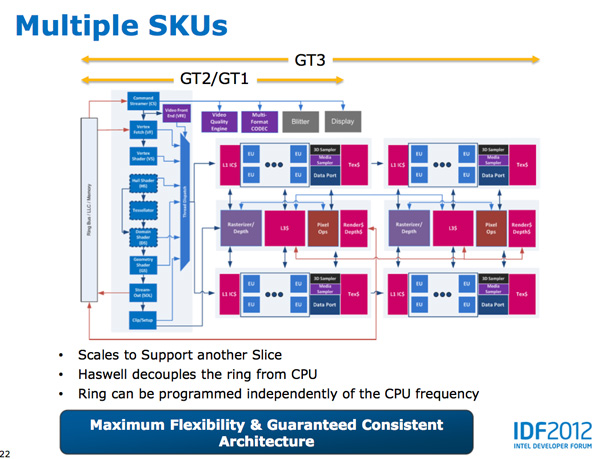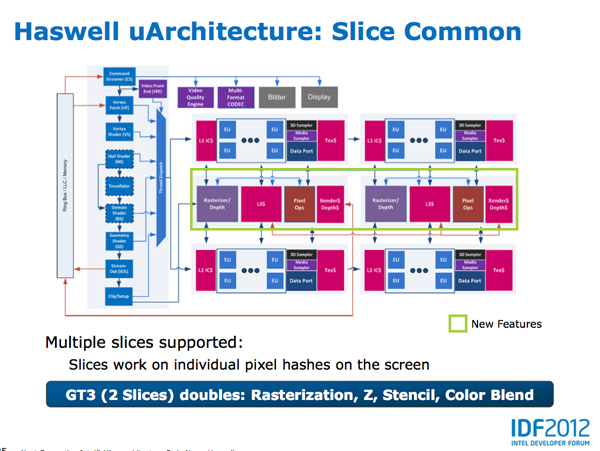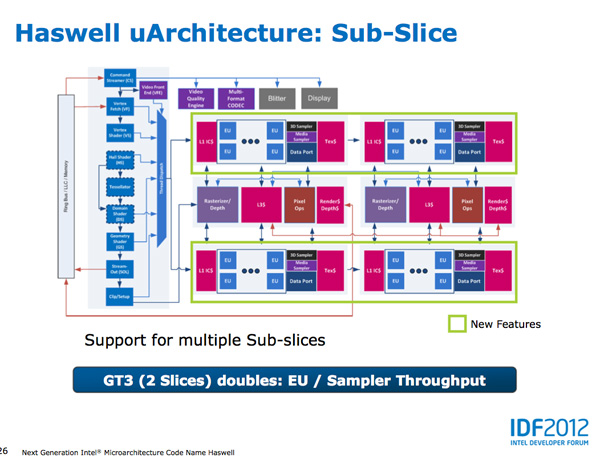Intel's Haswell Architecture Analyzed: Building a New PC and a New Intel
by Anand Lal Shimpi on October 5, 2012 2:45 AM ESTHaswell's GPU
Although Intel provided a good amount of detail on the CPU enhancements to Haswell, the graphics discussion at IDF was fairly limited. That being said, there's still some to talk about here.
Haswell builds on the same fundamental GPU architecture we saw in Ivy Bridge. We won't see a dramatic redesign/re-plumbing of the graphics hardware until Broadwell in 2014 (that one is going to be a big one).
Haswell's GPU will be available in three physical configurations: GT1, GT2 and GT3. Although Intel mentioned that the Haswell GT3 config would have twice the shader count of Haswell GT2, it was careful not to disclose the total number of EUs in any of the versions. Based on the information we have at this point, GT3 should be a 40 EU configuration while GT2 should feature 20 EUs. Intel will also be including up to one redundant EU to deal with the case where there's a defect in an EU in the array. This isn't an uncommon practice, but it does indicate just how much of the die will be dedicated to graphics in Haswell. The larger of an area the GPU covers, the greater the likelihood that you'll see unrecoverable defects in the GPU. Redundancy at the EU level is one way of mitigating that problem.
Haswell's processor graphics extends API support to DirectX 11.1, OpenCL 1.2 and OpenGL 4.0.
At the front of the graphics pipeline is a new resource streamer. The RS offloads some driver work that the CPU would normally handle and moves it to GPU hardware instead. Both AMD and NVIDIA have significant command processors so this doesn't appear to be an Intel advantage although the devil is in the (unshared) details. The point from Intel's perspective is that any amount of processing it can shift away from general purpose CPU hardware and onto the GPU can save power (CPU cores go to sleep while the RS/CS do their job).
Beyond the resource streamer, most of the fixed function graphics hardware sees a doubling of performance in Haswell.
At the shader core level, Intel separates the GPU design into two sections: slice common and sub-slice. Slice common includes the rasterizer, pixel back end and GPU L3 cache. The sub-slice includes all of the EUs, instruction caches and EUs.
In Haswell GT1 and GT2 there's a single slice common, while GT3 sees a doubling of slice common. GT3 similarly has two sub-slices, although once again Intel isn't talking specifics about EU counts or clock speeds between GT1/2/3.
The final bit of detail Intel gave out about Haswell's GPU is the texture sampler sees up to a 4x improvement in throughput over Ivy Bridge in some modes.
Now to the things that Intel didn't let loose at IDF. Although originally an option for Ivy Bridge (but higher ups at Intel killed plans for it) was a GT3 part with some form of embedded DRAM. Rumor has it that Apple was the only customer who really demanded it at the time, and Intel wasn't willing to build a SKU just for Apple.
Haswell will do what Ivy Bridge didn't. You'll see a version of Haswell with up to 128MB of embedded DRAM, with a lot of bandwidth available between it and the core. Both the CPU and GPU will be able to access this embedded DRAM, although there are obvious implications for graphics.
Overall performance gains should be about 2x for GT3 (presumably with eDRAM) over HD 4000 in a high TDP part. In Ultrabooks those gains will be limited to around 30% max given the strict power limits.
As for why Intel isn't talking about embedded DRAM on Haswell, your guess is as good as mine. The likely release timeframe for Haswell is close to June 2013, there's still tons of time between now and then. It looks like Intel still has a desire to remain quiet on some fronts.














245 Comments
View All Comments
Magik_Breezy - Sunday, October 14, 2012 - link
Probably real customer support without paying an extra $200Spunjji - Thursday, October 18, 2012 - link
Yawn.Spunjji - Thursday, October 18, 2012 - link
The bit that aggravates me the most is that even with this lavishing of review pages, the actual comparison of Apple products to competitors tends to lack (particularly with the Macbook article). This is understandable under some circumstances (iPhone battery life - new test, small selection of data points) but not for others.Arbee - Friday, October 5, 2012 - link
I'm not really seeing any of that. AT's Android and Windows Phone reviews are just as in-depth and complementary where due as their Apple ones. AFAIK both Anand's and Brian's daily-driver phones aren't iPhones, even. They care about the tech, not who it comes from. It just happens that Apple is often the original source of new and interesting things in that space. At this exact moment they're the only people shipping something new and interesting. When the Nokia 920 launches, I'm confident Anand and Brian will be ready with a 15+ page review and discussion of anything novel on the podcast, and when Winter CES brings us Tegra 4 and other Android news, I expect to see eye-glazing levels of detail here at AT.(As an aside, I smiled at how closely DPReview's discussion of the alleged "purple haze" problem tracked Brian's rant on the podcast - clearly both writers know what they're talking about, which can be a rare quantity in tech journalism).
VivekGowri - Saturday, October 6, 2012 - link
I think Anand's daily driver is an iPhone, but he frequently carries the latest Android/WP device on the side. Brian and myself end up daily driving like a half dozen phones a month, depending on what shows up at our doorstep.Zink - Saturday, October 6, 2012 - link
"iPad 3 form factor" was used because all of the other tablets have 25Wh batteries and draw about 5W max. The A5X iPad and it's giant 42.5Wh battery on the other hand can put out over 10W of heat which is the power envelope where Intel might target a Haswell SOC.amdwilliam1985 - Monday, October 8, 2012 - link
I totally agree with you on the Apple part. That's the biggest pullback on reading Anand writings. Too much Apple praising.I used to be an Apple fan, but recently they're becoming the biggest jerks in the technology industry. The human/ethical part of in me hates them so much, that I won't buy anything that has a Apple logo on it.
I gave away my iPad 2, switched to Samsung Galaxy S phones, and using my HP windows 7 laptop over the 2011 MBA.
-say NO to bully, say NO to Apple.
xaml - Thursday, May 23, 2013 - link
Number of problems solved with this approach: NO.dartox - Tuesday, November 27, 2012 - link
Probably because most people know about how large an iPad is - if he said "tablet" form factor that's ambigious.. and if he said "Motorola XOOM" form factor not as many people are familiar with the size.Paer0 - Friday, October 5, 2012 - link
Yes... Macs are well engineered and deliver a solid performance across board.